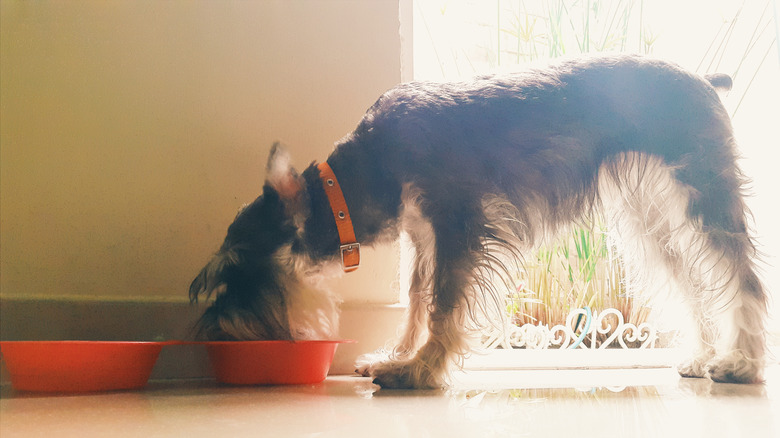Vet-Approved Homemade Dog Food
Grandmas everywhere will tell you: homemade is better than store-bought. Chances are, your dog agrees with Grandma. What dog doesn't love table scraps? The problem is, a bowl of your leftovers is not going to fulfill your dog's nutritional requirements. Some leftovers may even harm him. If you'd like to cook for your dog, all animal care professionals would agree that you should always use nutritionally complete recipes. Just as commercial dog foods must meet certain requirements for nutritional balance, your homemade food should meet and ideally exceed the minimum requirements for a well-balanced diet. Your vet can steer you in the right direction for preparing homemade dog diets or ask her about the suitability of particular veterinary-endorsed diets for your dog.
Basic components of balanced dog food
Basic components of balanced dog food
Your homemade meal must contain protein, fiber, and carbohydrates. Puppies require about 25-percent protein in their meals, while 18 percent is sufficient for adults. However, protein needs change according to your dog's age and vary according to breed, so check with your vet regarding the right amount for your dog. You might have noticed that commercial dog foods often don't list the percentage of carbohydrates. That's because the proper percentage of carbs in the dog's diet is still not set in stone by the veterinary community and regulators. If you're making your dog's meals yourself, you have the freedom to purchase the freshest, highest-quality ingredients available. Make sure you weigh your dog frequently to verify he stays a healthy weight. Take your dog to the vet before starting the homemade diet so your vet can determine your dog's ideal weight.
Sample vet-approved recipes
Sample vet-approved recipes
Massachusetts' MSCPA-Angell Animal Medical Center provides sample recipes on its website for dogs weighing 15, 30 and 60 pounds. It recommends the same basic ingredients for all sizes, just at differing amounts. The primary protein source is dark chicken, but you can substitute with turkey, lamb, pork, beef, or eggs in the same proportions. Carbohydrates might consist of pasta, white or brown rice, sweet potato, barley, peas, corn, or oatmeal. Grains and meat should be cooked. Fiber comes from carrots, bell peppers, green beans, baby spinach, squash, or broccoli but such fibrous matter should be no more than 10 percent of the dog's entire dietary intake. Vegetables can be cooked or uncooked.
For a 15-pound dog, mix:
• 3 ounces of a cooked protein source (dark chicken, turkey, lamb, pork, beef, or eggs)
• 1 1/3 cups of cooked carbohydrates (rice, sweet potato, barley, peas, corn, or oatmeal)
• 1 tablespoon of vegetables, cooked or uncooked (carrots, bell peppers, green beans, baby spinach, squash, or broccoli)
• 1 to 2 teaspoons of a fat source such as vegetable oil.
For a 30-pound dog, use:
• 4.5 ounces of the cooked protein source (dark chicken, turkey, lamb, pork, beef, or eggs),
• 2 cups of cooked carbohydrates (rice, sweet potato, barley, peas, corn, or oatmeal)
• 1.5 tablespoons of vegetables (carrots, bell peppers, green beans, baby spinach, squash, or broccoli)
• 2-to-3 teaspoons of a fat source such as vegetable oil
For a 60 pound dog, use:
• 8 ounces of the cooked protein source (dark chicken, turkey, lamb, pork, beef, or eggs)
• 3.5 cups of cooked carbohydrates (rice, sweet potato, barley, peas, corn, or oatmeal)
• 3 tablespoons of vegetables
• 3-to-5 teaspoons of a fat source such as vegetable oil
As a supplement, MSPCA-Angell AMC recommends Balance IT, available from veterinarians.
Founder's Veterinary Clinic of Brea, California, offers a sample recipe for 20-pound dogs that you can half for 10-pounders or double for 40-pound canines.
For 20 lb dogs (Halve for 10 lb dog, double for 40 lb dog):
• 1/4 pound of cooked, skinless chicken
• 1 cup of cooked brown rice
• 1 cup of peas and carrots
• 1 tablespoon of vegetable oil
• 1/4 teaspoon of potassium chloride (a salt substitute).
Substitutions for this recipe differ slightly from those allowed with the recipe from MSCPA-Angell Animal Medical Center in that FVC's allows boned fish as a protein source and potato as a carbohydrate. FVC suggests adding calcium citrate or bonemeal powder to ensure that your home cooking doesn't result in calcium deficiency. It also recommends daily multiple vitamins designed for dogs.
Ask your vet
Ask your vet
If your dog suffers from medical issues, you might need to adjust certain veterinary-endorsed diets. Ask your own vet about your dog's specific nutritional needs as well as for a recommendation for a certified veterinary nutritionist. The three of you can find a homemade diet that meets your pup's dietary requirements. Whether your dog has specific medical problems or not, you should always tell your vet that your dog eats a homemade diet. You should also add veterinarian-recommended supplements to the homemade diet's basic components.
Homemade raw food diets = mixed opinions
Homemade raw food diets = mixed opinions
The raw food diet has gained popularity and is also known as the Biologically Appropriate Raw Food, or BARF, diet. The concept was developed by an Australian veterinarian, Dr. Ian Billinghurst. BARF's philosophy states that "the diet a dog evolved to eat over many millions of years of evolution is the best way to feed it." While you might find some veterinarians recommending homemade raw foods for dogs similar to what ancient canines ate that's not the view of the American Veterinary Medical Association. The AVMA, along with the U.S. Food and Drug Administration Center for Veterinary Medicine and the U.S. Centers for Disease Control and Prevention don't recommend making your own raw dog food because of the risk of bacterial contamination or possible public health risks.
